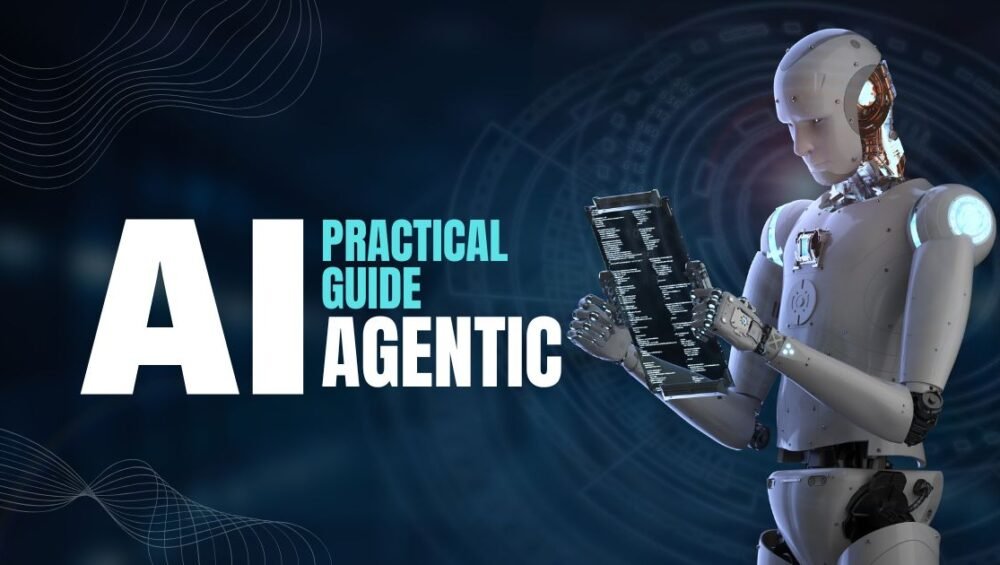Learn what agentic AI is, how it works, real use cases, risks, and a step-by-step blueprint to build safe, goal-driven AI agents.
What Is Agentic AI?
Agentic AI represents a shift from simple text prediction models to autonomous systems that can set goals, plan steps, call tools, and act to reach an outcome. Unlike traditional AI that waits for direct input and produces a single response, Agentic AI actively identifies what needs to be done, breaks tasks into smaller steps, and executes actions with the ability to check its own work. If a traditional model behaves like an intern waiting for instructions, an agent behaves more like a motivated teammate who understands the objective, strategizes the path, and delivers results.
From Predictive Text to Autonomous Agents
Large language models became popular for their ability to generate text responses. However, prediction alone is not enough for handling complex tasks such as reconciling invoices, booking travel, or debugging code. Agentic AI adds planning, tool use, and memory to the foundation of language models. This means the system can understand context, decide the best actions, use external tools, and learn from outcomes. The result is a model that does not just talk—it actually gets things done.
The Core Traits of Agentic AI
Agentic AI is defined by a set of traits that make it distinct. It is goal-oriented and works toward achieving specific outcomes rather than just producing replies. It operates autonomously but always within the boundaries set by developers or organizations. It is capable of using tools, whether that means querying a database, calling an API, or running scripts. Memory is another core aspect, as agents can remember facts, decisions, and preferences to maintain continuity. Finally, Agentic AI incorporates self-evaluation, which allows it to critique its progress, identify errors, and correct mistakes as it works.

How Agentic AI Works
At its core, Agentic AI functions in a cycle that can be described as sense, plan, act, and reflect. This loop repeats until the task is successfully completed, a limit is reached, or the system is stopped.
Perception and Context Building
The first step involves building an understanding of the context. The agent gathers information from the user’s request, past conversations, and relevant data sources. This context acts as a briefing, giving the agent the clarity it needs to avoid errors and stay on track.
Planning and Task Decomposition
Once the context is set, the agent decomposes a goal into smaller, manageable sub-goals. For example, the request to launch a newsletter may be broken down into defining the audience, selecting a platform, drafting the content, scheduling delivery, and later monitoring performance. Plans are flexible, so if one step fails, the agent adapts and finds an alternative.
Tool Use and Actuation
Agentic AI gains its real power through the ability to use tools. It can query customer records, interact with payment systems, trigger automations, or even run code. With the right integrations, the agent becomes capable of interacting with digital environments in ways that traditional models cannot.
Memory and Reflection
Memory is what allows an agent to go beyond isolated responses. Short-term memory helps it handle immediate tasks, while long-term memory enables it to recall important facts or lessons from past interactions. Reflection plays a vital role by letting the agent review its work, identify gaps, and improve iteratively until it achieves the desired result.
Feedback Loops and Self-Improvement
Agents are designed to learn from their actions. By logging what worked and what failed, they improve over time. They gradually refine their strategies, learn which tools are most reliable, and reduce wasted effort. This creates a continuous improvement loop that makes the system smarter with use.
Single-Agent vs Multi-Agent Systems
Some tasks can be handled by a single agent, but complex projects often benefit from multiple agents working together. Multi-agent systems allow specialization, where each agent can focus on a particular role.
Collaboration Patterns and Hand-offs
In multi-agent setups, collaboration becomes essential. One agent may draft work while another reviews it. A planner can design strategies while an executor carries them out. In some cases, teams of agents act as specialized pods, where each plays a role similar to human departments such as research, writing, or editing.
Orchestrators vs Swarms
There are two main approaches to multi-agent systems. In orchestrated setups, a central controller manages all agents, assigning tasks and resolving conflicts. In swarm setups, agents work more independently, communicating with each other to solve problems collectively. Orchestration offers predictability, while swarms provide flexibility and emergent problem-solving.

The Agentic AI Stack
Building Agentic AI involves a stack of components that work together, much like assembling a team.
Models and Reasoning Modes
Different models serve different purposes. Some are optimized for speed and routing simple tasks, while others are more powerful and handle complex reasoning. Combining multiple models allows organizations to balance cost, speed, and accuracy.
Tools, APIs, and Integrations
The strength of an agent lies in its ability to integrate with tools. These may include customer databases, workflow systems, spreadsheets, or even browsers. Proper integration ensures the agent can take real-world actions rather than just providing suggestions.
Short-Term and Long-Term Memory Stores
Short-term memory helps the agent keep track of current conversations or tasks, while long-term memory stores reusable knowledge. These memory stores are crucial for continuity, personalization, and learning from experience.
Controllers, Policies, and Guardrails
Controllers act as the safety net, deciding if an action should be approved or denied. Guardrails define what the agent is allowed to do, including data handling rules, spending limits, and approval requirements for sensitive actions.
Observability, Logging, and Safety
Logging and observability provide visibility into what the agent is doing. Every tool call, decision, and response can be monitored to ensure compliance and safety. This is where risk management and security become essential.

Practical Use Cases
Agentic AI is not theoretical—it is already transforming industries. In customer support, agents can handle inquiries, suggest replies, and update systems automatically. In research, they collect data, summarize findings, and prepare reports. In software engineering, they write code, test it, and even manage deployments. Operational workflows benefit as well, with agents replacing rigid scripts with adaptable automation. In data analysis, they fetch datasets, run queries, and present insights in natural language.
Designing an Agent End-to-End
Designing an agent begins with clear objectives. The goals must be measurable, constraints well defined, and success criteria specified. Prompting patterns such as ReAct reasoning, tree-of-thoughts, and reflexion methods can help agents reason more effectively. Evaluation should focus on success rates, latency, cost, and human feedback. Human-in-the-loop processes remain important to review actions and maintain trust.
Risks and Limitations
Like all technology, Agentic AI carries risks. Hallucinations remain a problem, and when agents act autonomously, the consequences can be significant. Security is another concern, as prompt injection and data leaks can compromise systems. Ethical issues also arise, particularly around bias, privacy, and compliance with regulations. Strong guardrails and oversight are essential to mitigate these risks.

Implementation Blueprint
The best way to implement Agentic AI is to start small with clearly scoped workflows. Narrow use cases such as handling Tier-1 customer support tickets provide valuable learning opportunities without large risks. Once successful, integration can expand to more complex areas. Cost management, model optimization, and careful tuning are part of the ongoing process. The key is to build incrementally, measure performance, and adapt.
Future Trends
The future of Agentic AI points toward smaller, specialized models that handle tasks efficiently while escalating complex issues to larger models. On-device agents are likely to become common, providing faster responses and greater privacy. Regulation and standards will also shape adoption, creating trust and accountability in how agents operate across industries.
Conclusion
Agentic AI is transforming artificial intelligence from a passive assistant into an active collaborator. By combining planning, tool use, memory, and reflection, it delivers outcomes rather than just answers. With the right guardrails, observability, and human oversight, organizations can safely deploy agents that streamline work, reduce costs, and continuously improve. The journey starts small but can evolve into a complete transformation of how tasks are performed and decisions are made.






